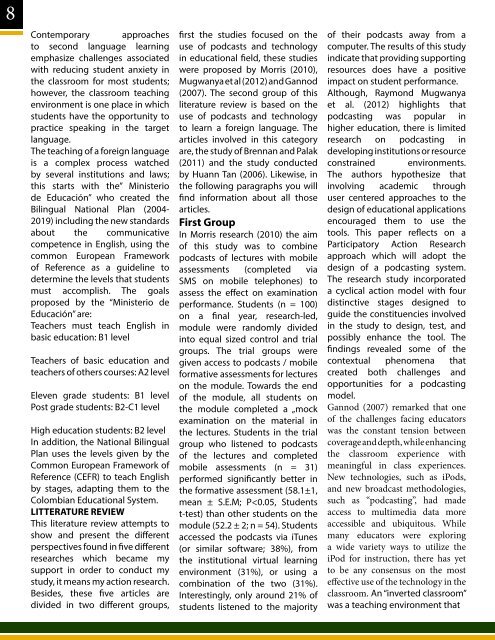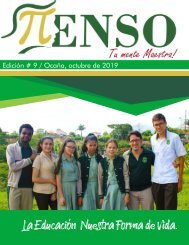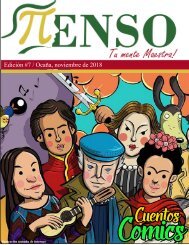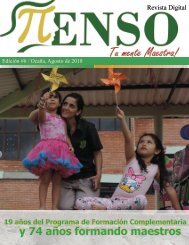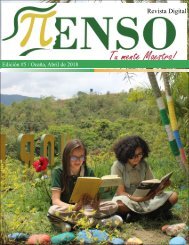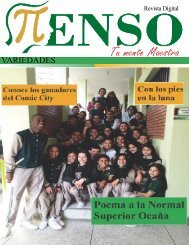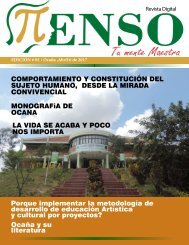Create successful ePaper yourself
Turn your PDF publications into a flip-book with our unique Google optimized e-Paper software.
8<br />
Contemporary approaches<br />
to second language learning<br />
emphasize challenges associated<br />
with reducing student anxiety in<br />
the classroom for most students;<br />
however, the classroom teaching<br />
environment is one place in which<br />
students have the opportunity to<br />
practice speaking in the target<br />
language.<br />
The teaching of a foreign language<br />
is a complex process watched<br />
by several institutions and laws;<br />
this starts with the” Ministerio<br />
de Educación” who created the<br />
Bilingual National Plan (2004-<br />
2019) including the new standards<br />
about the communicative<br />
competence in English, using the<br />
common European Framework<br />
of Reference as a guideline to<br />
determine the levels that students<br />
must accomplish. The goals<br />
proposed by the “Ministerio de<br />
Educación” are:<br />
Teachers must teach English in<br />
basic education: B1 level<br />
Teachers of basic education and<br />
teachers of others courses: A2 level<br />
Eleven grade students: B1 level<br />
Post grade students: B2-C1 level<br />
High education students: B2 level<br />
In addition, the National Bilingual<br />
Plan uses the levels given by the<br />
Common European Framework of<br />
Reference (CEFR) to teach English<br />
by stages, adapting them to the<br />
Colombian Educational System.<br />
LITTERATURE REVIEW<br />
This literature review attempts to<br />
show and present the different<br />
perspectives found in five different<br />
researches which became my<br />
support in order to conduct my<br />
study, it means my action research.<br />
Besides, these five articles are<br />
divided in two different groups,<br />
first the studies focused on the<br />
use of podcasts and technology<br />
in educational field, these studies<br />
were proposed by Morris (2010),<br />
Mugwanya et al (2012) and Gannod<br />
(2007). The second group of this<br />
literature review is based on the<br />
use of podcasts and technology<br />
to learn a foreign language. The<br />
articles involved in this category<br />
are, the study of Brennan and Palak<br />
(2011) and the study conducted<br />
by Huann Tan (2006). Likewise, in<br />
the following paragraphs you will<br />
find information about all those<br />
articles.<br />
First Group<br />
In Morris research (2010) the aim<br />
of this study was to combine<br />
podcasts of lectures with mobile<br />
assessments (completed via<br />
SMS on mobile telephones) to<br />
assess the effect on examination<br />
performance. Students (n = 100)<br />
on a final year, research-led,<br />
module were randomly divided<br />
into equal sized control and trial<br />
groups. The trial groups were<br />
given access to podcasts / mobile<br />
formative assessments for lectures<br />
on the module. Towards the end<br />
of the module, all students on<br />
the module completed a „mock<br />
examination on the material in<br />
the lectures. Students in the trial<br />
group who listened to podcasts<br />
of the lectures and completed<br />
mobile assessments (n = 31)<br />
performed significantly better in<br />
the formative assessment (58.1±1,<br />
mean ± S.E.M; P


